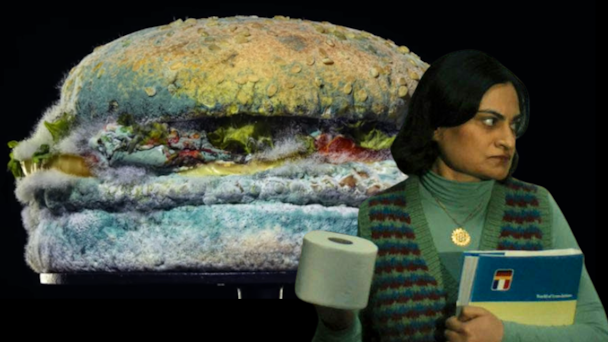Gag reflex: why gross humor in ads can often leave a bad smell
Sometimes a negative impression, while lasting, won’t help your brand. To prove it, DAIVID’s Ian Forrester takes a slightly too close look at Andrex’s ‘First Office Poo.’

The image of the ‘Moldy Whopper’ still sticks in my head every time I consider ordering from Burger King.
Yes, it was an unforgettable campaign. It was almost universally loved. And it won a ton of awards. But ever since this stunt highlighted it is removing artificial preservatives from its food, I’ve never been back.
I know it’s wrong.
As someone who has worked in the ad industry for over 15 years, I should recognize that amid a sea of sameness, Burger King stood out. And for something.
But it was really disgusting. I can’t stop thinking about how that furry burger would feel and taste in my mouth.
Why am I talking about a campaign that came out in early 2020?
Well, I was reminded of it while watching Andrex’s latest ad campaign – ‘First Office Poo.’
As part of its ‘Get Comfortable campaign,’ Andrex aims to ‘pull the chain’ on people’s squeamishness and prudishness around using public lavatories.
‘First Office Poo,’ as the title suggests, focuses on people’s hang-ups around going to the toilet at work. According to the brand’s research, 47% of UK adults won’t have a poo in the office. It features a woman who, after breaking wind, is finally forced to run the gauntlet of going to the office loo. It’s all done with a heavy dose of toilet humor – the highlight being her taking a French-German dictionary into the bogs to read.
Created alongside a great partnership with Bowel Cancer UK and run during Bowel Cancer Awareness Month, it is a distinct departure from Andrex’s previous cute ads (although the puppy does get a cameo).
So what’s that got to do with moldy burgers? Apart from the fact you’d definitely have to visit the loo after having one... well...
Can disgust build trust?
It got me thinking about using negative emotions and whether they are effective at driving action for commercial brands.
Like the Whopper ad, the ad has attracted a lot of praise in the press for its bravery in tackling the UK’s toilet taboos. But would that be enough to compel someone actually to buy Andrex toilet paper if they weren’t already? Judging by the YouTube comments alone – not always the best barometer – the public doesn’t appear convinced (Update: They’ve now been turned off). But we should never discount the views of the silent majority who don’t feel the need to leave comments on toilet paper ads.
So, using DAIVID’s tech and methodology on 300 UK consumers, we measured the emotional and brand impact of two Andrex campaigns – ‘First Office Poo’ and ‘A Little Love Goes A Long Way,’ a recent cutesy campaign that follows the traditional puppy-powered adorableness the brand is well known for. This included measuring their facial expressions and then asking them how they felt after watching. We also looked at the impact the ad had on various brand metrics.
‘First Office Poo’ only managed higher-than-average scores in six of the 26 positive emotions we tested. Amusement was the strongest positive emotion, but only 16.7% found the ad funny. Caveat: that’s twice the UK average for an ad, but if the ad is designed to be funny, surely you have to make more than a sixth chortle?
As we know, despite a huge focus on advertisers being funny right now, humor is a tough nut to crack, and brands always risk alienating their audience if their jokes don’t land.
The ad was also twice as likely to surprise people than the average UK ad. Certainly, after becoming accustomed to the usual ads for toilet paper featuring pristine white bathrooms, this is certainly something that would stand out from the usual fare. That office sure is grotty and oppressive.
But what would it be remembered for?
Negative emotions were certainly more dominant, with the ad 4X more likely to leave viewers feeling embarrassed and awkward after watching than the average UK ad. Feelings of confusion and disgust were also way above the average, at 246% and 215% respectively.
When compared with the more conventional ‘A Little Love, ’ you see how much of a departure this is. While awkwardness, embarrassment, amusement and confusion were the top emotions for ‘First Office Poo,’ ‘A Little Love’ generated intense feelings of warmth (3x higher than the UK average), calmness (nearly 4x) and adoration (3x).
Such a change in direction was certainly memorable, with brand recall for ‘First Office Poo’ 8% higher than the UK average. Although it is still slightly below ‘A Little Love,’ which managed a 15% uplift.
But what’s interesting is that it didn’t necessarily translate into action. The problem with ‘taboo’ ads is that viewers tend to be less likely to share the ad, search for the brand or recommend the brand after watching. Purchase intent was also on a par with the UK average.
‘A Little Love’ fared slightly better. Overall, ‘Office Poo’ managed an effectiveness (CES) score of 6.2 out of 10, while ‘A Little Love’ fared better at 6.7.
Always have a back-up emotion
All in all, while Andrex rightfully has been praised for trying something different and purposeful, the campaign highlights some of the pitfalls of using humor, especially when paired with negative emotions. To avoid the risk of all your hard work going down the pan, you always need a backup emotion in case the joke fails to land.
In the case of ‘First Office Poo,’ those were predominantly feelings of awkwardness, embarrassment, confusion and disgust – the same reasons I’m guessing half of UK workers refuse to use the company loo.
Departing from your tried and tested emotions can pay huge dividends, as this is the path to create distinctive content, but brands have to be careful which emotions they evoke. If a brand evokes negative emotions and leaves the viewer feeling negative at the end of the ad, those emotions can be attached to the brand.
The best approach for brands is to investigate the under-used positive emotions in the category. By moving into this positive emotional space, brands can create ads that are distinctive and memorable in a good way. Otherwise, like rotting Whoppers, they can leave a bad taste in the mouth.
Ian Forrester is the CEO of the creative effectiveness platform DAIVID. He’s a regular contributor to The Drum. Below is a mix of humor in advertising pieces that I suspect you'll like too.

